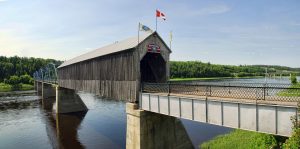Rimouski Origins & Evolution
Located on the southern bank of Saint Lawrence River, Rimouski holds an integral part of Quebec’s history. Rimouski’s origins date back to 1696, and the city has evolved over the centuries into a hub of education, culture, and commerce. Known for its role as the capital of the Bas-Saint-Laurent region, Rimouski played a significant part in the colonization of the Gaspe Peninsula. The city has remained vibrant and dynamic amid changing times, which is evident through its diverse population, remarkable landmarks, and engaging activities.
Today, Rimouski harbors considerable economic activity, largely driven by its strategic location as a major port. It serves as a link between the Gaspe Peninsula and Quebec’s heartlands, continuing its vital role in the province’s maritime commerce. The city remains full of historical charm, built upon layers of architectural styles that reflect its rich history.
City’s Geography & Demography
Rimouski is strategically located at the mouth of the Rimouski River, a significant location on the maritime route along the Saint Lawrence River. It encounters a humid continental climate throughout the year, which adds a unique charm to its distinct seasons. The city enjoys warm, pleasant summers and experiences snowy winters, making it a fantastic spot for outdoor recreation and adventures.
As for demography, Rimouski’s population reflects the typical diversity of a vibrant city, home to about 50,000 residents. These residents are largely of French-Canadian descent, with French being the dominant language. The city’s youthful and dynamic demography stems from its role as an educational hub, hosting the Université du Québec à Rimouski, one of Quebec’s most significant universities.
Cultural & Artistic Landscape in Rimouski
Rimouski is home to a rich and varied cultural landscape. Notable events include the Grandes Fêtes du St-Laurent, a summer music festival that attracts thousands of visitors each year. The Rimouski Film Festival (Festival de cinéma de la ville de Rimouski) is another cultural highlight that showcases international films and promotes local talent.
The city is also known for its many museums, theaters, and galleries. Most notable among these is the Regional Museum of Rimouski (Musée Régional de Rimouski), which preserves and showcases the city’s historical and cultural legacy. Rimouski’s cultural landscape is further enriched by the presence of several art galleries, including the Maison de la culture de Rimouski and the Caravansérail artist center.
Educational & Research Facilities
Rimouski is renowned as an education and research hub, particularly because of the Université du Québec à Rimouski (UQAR). UQAR stands among the top universities in Canada and is renowned for its excellent research programs, especially in the fields of marine sciences, geography, nursing, and business administration. The university attracts thousands of students from different parts of the country and globally.
In addition, the city features several well-equipped libraries such as the Judith-Jasmin Library, contributing to the city’s educational prowess. Among the top research institutions here are the Maritime Institute of Quebec and the Canadian Forest Service, underlining Rimouski’s importance as a center of knowledge and learning.
Rimouski’s Highlights & Recreation
There’s a wealth of landmarks and recreational spots in Rimouski for visitors and locals alike to explore. The Pointe-au-Père lighthouse, which is part of the Pointe-au-Père Maritime Historic Site, is a must-see. The site also houses the Empress of Ireland Museum.
Moreover, the Bic National Park is a picturesque landscape spread across 33.2 square kilometers. Known for its diverse flora and fauna, the park is frequented by bird-watchers and nature enthusiasts throughout the year. The numerous biking and walking tracks across the city, along with skiing opportunities at the Val Neigette, further enhance Rimouski’s appeal as a recreational hub.
Commerce & Conveniences
Rimouski’s trade districts offer an array of boutique shops, specialty stores, and plenty of dining options. The city hosts annual seasonal sales that draw crowds from nearby cities and towns. For everyday conveniences, there are plenty of banks, postal services, and supermarkets spread across the city to cater to both locals and tourists’ needs.
Transport & Connectivity
Served by the Rimouski-Neigette regional county municipality’s public transit system (Réseau de transport collectif régional de Rimouski-Neigette), Rimouski is well-connected with regular services ensuring connectivity within and beyond the city. Notably, the Rimouski Airport, located just north of the city, facilitates easy air access for visitors. Besides, the city’s deep-water port acts as a crucial transit hub for maritime commerce.
Sports Facilities
For sports enthusiasts, Rimouski is home to the Colisée Financière Sun Life, where the city’s local ice hockey team, the Rimouski Océanic, plays. The city also boasts several sports centers and public parks that host various sporting activities including soccer, baseball, and tennis, further inspiring an active lifestyle among its dwellers.
Traveler’s Final Take
Rimouski isn’t just an ordinary city; it’s a radiant blend of history, culture, education, and recreation with a warm and welcoming charm. Whether you’re a history enthusiast, a culture vulture, a student, or an adventurer, there’s something in Rimouski for everyone.
Must-Visit Spots in Rimouski: Grandes Fêtes du St-Laurent, Rimouski Film Festival, Musée Régional de Rimouski, Maison de la culture de Rimouski, Caravansérail artist center, Université du Québec à Rimouski, Judith-Jasmin Library, Maritime Institute of Quebec, Canadian Forest Service, Pointe-au-Père lighthouse, Empress of Ireland Museum, Bic National Park, Val Neigette, Colisée Financière Sun Life.









